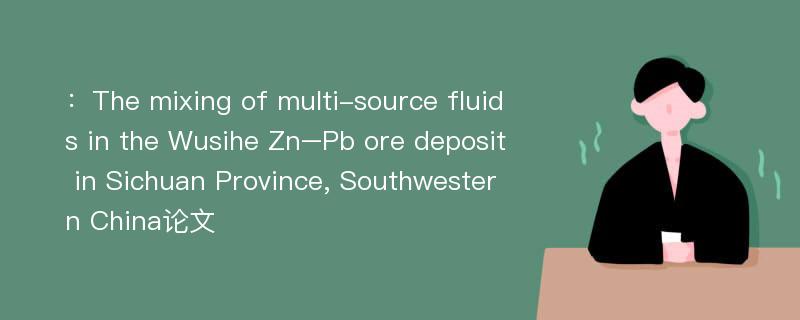
本文主要研究内容
作者(2019)在《The mixing of multi-source fluids in the Wusihe Zn–Pb ore deposit in Sichuan Province, Southwestern China》一文中研究指出:The Sichuan–Yunnan–Guizhou(SYG) metallogenic province of southwest China is one of the most important Zn–Pb ore zones in China, with ~200 Mt Zn–Pb ores at mean grades of 10 wt.% Zn and 5 wt.% Pb. The source and mechanism of the regional Zn–Pb mineralization remain controversial despite many investigations that have been conducted. The Wusihe Zn–Pb deposit is a representative large-scale Zn–Pb deposit in the northern SYG, which mainly occurs in the Dengying Formation and yields Zn–Pb resources of ~3.7 Mt. In this paper, Zn and S isotopes, and Fe and Cd contents of sphalerite from the Wusihe deposit were investigated in an attempt to constrain the controls on Zn and S isotopic variations, the potential sources of ore-forming components, and the possible mineralization mechanisms. Both the δ66Zn and δ34S values in sphalerite from the Wusihe deposit increase systematically from the bottom to the top of the strata-bound orebodies. Such spatial evolution in δ66Zn and δ34S values of sphalerite can be attributed to isotopic Rayleigh fractionation during sphalerite precipitation with temperature variations. The strong correlations between the Zn–Sisotopic compositions and Fe–Cd concentrations in sphalerite suggest that their variations were dominated by a similar mechanism. However, the Rayleigh fractionation mechanism cannot explain the spatial variations of Fe and Cd concentrations of sphalerite in this deposit. It is noted that the bottom and top sphalerites from the strata-bound orebodies document contrasting Zn and S isotopic compositions which correspond to the Zn and S isotopic characteristics of basement rocks and host rocks, respectively. Therefore, the mixing of two-source fluids with distinct Zn–S isotopic signatures was responsible for the spatial variations of Zn–S isotopic compositions of sphalerite from the Wusihe deposit. The fluids from basement rocks are characterized by relatively lighter Zn(~0.2 %)and S(~5 %) isotopic compositions while the fluids from host rocks are marked by relatively heavier Zn(~0.6 %)and S(~15 %) isotopic compositions.
Abstract
The Sichuan–Yunnan–Guizhou(SYG) metallogenic province of southwest China is one of the most important Zn–Pb ore zones in China, with ~200 Mt Zn–Pb ores at mean grades of 10 wt.% Zn and 5 wt.% Pb. The source and mechanism of the regional Zn–Pb mineralization remain controversial despite many investigations that have been conducted. The Wusihe Zn–Pb deposit is a representative large-scale Zn–Pb deposit in the northern SYG, which mainly occurs in the Dengying Formation and yields Zn–Pb resources of ~3.7 Mt. In this paper, Zn and S isotopes, and Fe and Cd contents of sphalerite from the Wusihe deposit were investigated in an attempt to constrain the controls on Zn and S isotopic variations, the potential sources of ore-forming components, and the possible mineralization mechanisms. Both the δ66Zn and δ34S values in sphalerite from the Wusihe deposit increase systematically from the bottom to the top of the strata-bound orebodies. Such spatial evolution in δ66Zn and δ34S values of sphalerite can be attributed to isotopic Rayleigh fractionation during sphalerite precipitation with temperature variations. The strong correlations between the Zn–Sisotopic compositions and Fe–Cd concentrations in sphalerite suggest that their variations were dominated by a similar mechanism. However, the Rayleigh fractionation mechanism cannot explain the spatial variations of Fe and Cd concentrations of sphalerite in this deposit. It is noted that the bottom and top sphalerites from the strata-bound orebodies document contrasting Zn and S isotopic compositions which correspond to the Zn and S isotopic characteristics of basement rocks and host rocks, respectively. Therefore, the mixing of two-source fluids with distinct Zn–S isotopic signatures was responsible for the spatial variations of Zn–S isotopic compositions of sphalerite from the Wusihe deposit. The fluids from basement rocks are characterized by relatively lighter Zn(~0.2 %)and S(~5 %) isotopic compositions while the fluids from host rocks are marked by relatively heavier Zn(~0.6 %)and S(~15 %) isotopic compositions.
论文参考文献
论文详细介绍
论文作者分别是来自Acta Geochimica的,发表于刊物Acta Geochimica2019年05期论文,是一篇关于,Acta Geochimica2019年05期论文的文章。本文可供学术参考使用,各位学者可以免费参考阅读下载,文章观点不代表本站观点,资料来自Acta Geochimica2019年05期论文网站,若本站收录的文献无意侵犯了您的著作版权,请联系我们删除。
